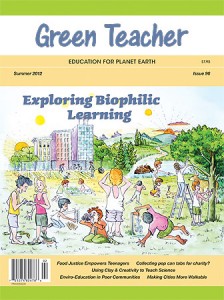Green Teacher 96, Summer 2012
Purchase this issue or subscribe
Features
Exploring the Twin Landscapes of Biophilic Learning by Terril L. Shorb
These nine mini-activities for all ages help enrich our relationship with nature and with others by tapping our innate need as human creatures to affiliate with the habitats, creatures, and processes of the natural world
Pedestrian City by Josh Fullan
Help middle and high school students investigate the walkability of their urban neighbourhoods to prepare them to become globally-minded and locally-engaged citizens with these 3 urban mobility activities
Click here for 2 examples of student maps
Letterboxing by Vivian Williams
A multi-disciplinary treasure hunt that helps young people learn about the landscape around them
Environmental Education in Impoverished Communities by Donald Hammond
How one high school bridged the gap between economic status and making a positive impact through environmental programs
Food Justice Empowers Teenagers by Gwendolyn Eden
Students from low-income families probe inequity around healthy, affordable food in their high school language arts class
Click here for an example of a hand-drawn organizer to use in this lesson
Connecting Art and Science by Amanda Berlinski
Using clay, creativity and colours to teach environmental science concepts such as biodiversity and evolutionary adaptations to 10-18 year olds
Click here to download the “Making Adaptations” worksheet referred to in the article
Endangered Animals and Science Literacy by Lindsey Hagen
Fostering concern for endangered species among students aged 8-14 with a series of lessons that connect language arts and science
Mapping to Increase Student Awareness of Local Wildlife by Hannah Wyatt
Two simple activities that help middle school students increase their sense of connection with their natural surroundings
Collecting Pop Can Tabs for Charity by Bert Murphy
Are these fundraising programs worth the effort, or do they do more harm than good?
Herpetology for High School Students by Catherine E. Matthews and Terry Tomasek (Free article)
Giving young people opportunities for hands-on field experiences with local species results in a successful and authentic environmental education program
Educational Resources Reviewed
Fifty Animals that Changed the Course of History (Eric Chaline)
Going Blue (Cathryn Berger Kaye and Philippe Cousteau)
Touch The Earth CD (Joe Reilly)
The Man Who Stopped the Desert DVD (1080 Film and Television Ltd.)
Spark Kids Series (Grace Commons and Maureen Dooley)
Earth Science Puzzles (Kim Kastens and Margie Turrin)
Yoga 4 Classrooms (Yoga 4 Classrooms)
Native American Games and Stories (James and Joseph Bruchac)
Nature Inside Out (Pam Newitt)
Get the Scoop on Animal Poop (Dawn Cusick)
Breaking Through Concrete (David Hanson and Edwin Marty)
Animals that Changed the World (Keltie Thomas)
Awesome Snake Science! (Cindy Blobaum)
Real World Math: Engaging Students Through Global Issues (Facing the Future)
Nest, Nook & Cranny (Susan Blackaby)
Roots and Research in Urban School Gardents (Veronica Gaylie)
Advanced Classic Solo Canoeing DVD (Becky Mason and Reid McLachlan)
Exploring Coral Reefs: Reproduction and Survival & Climate Change and Coral Reefs DVDs (The Video Project)
How to Boil a Frog DVD (The Video Project)
Tracks, Scat, and Sign Discovery Kit (Acorn Naturalists)
Books for Young Readers
Rachel: The Story of Rachel Carson (Amy Ehrlich & Wendell Minor)
Jo MacDonald Saw a Pond (Mary Quattlebaum & Laura J. Bryant)
The Good Garden (Katie Smith Milway & Sylvie Daigneault)
Into the A, B, Sea (Deborah Rose & Steve Jenkins)
Sheila Says We’re Weird (Ruth Ann Smalley & Jennifer Emery)
See all back issues
Order this issue online
Leave a Reply
You must be logged in to post a comment.











